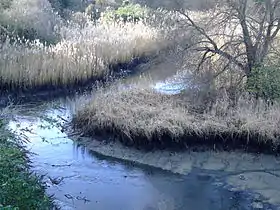Ebbsfleet River
Ebbsfleet River in Kent, south-east England, is a tributary of the Thames Estuary. It joins the Thames at Northfleet, opposite the container port of Tilbury Docks. Today, the river gives its name to the Ebbsfleet Garden City which is currently (2020) being developed in and around the course of the Ebbsfleet.
| Ebbsfleet River | |
|---|---|
 The Ebbsfleet River just before it enters the Thames Estuary at Northfleet | |
| Physical characteristics | |
| Source | |
| • location | Eight natural springs at Springhead TQ 616728 |
| • coordinates | 51°26′13″N 0°18′54″E |
| • elevation | 10 m (33 ft) |
| Mouth | |
• location | River Thames estuary TQ 620750 |
• coordinates | 51°27′01″N 0°19′47″E |
• elevation | 0 m (0 ft) |
| Length | 2.4 miles (3.9 km) |
History
It was formerly known as the River Fleet, giving its name to Northfleet and Southfleet. Its source was eight natural springs at Springhead. In Roman times the source was the site of a Roman settlement with many temples called Vagniacis, and the river was used to link Watling Street to the River Thames; in the fourteenth century it was a stopping place for pilgrims going to Canterbury.[1][2] A bridge across the river at Northfleet is mentioned in 1451 and it was still tidal and used for shipping in the sixteenth century.
In the nineteenth century the river was the earliest centre in Britain for the commercial cultivation of watercress, begun by William Bradbery in 1808.[3] He moved the business to West Hyde, Hertfordshire in 1820.
Following the removal of its waters in around 1901, when all its waters were used by the local water company, its dried riverbed was the subject of a botanical study by Marie Stopes, the birth control activist.[4] Parts of the river can still be seen.
Before 1960 the Ebbsfleet received the discharge from the Northfleet sewage works, this effluent was subsequently piped direct to Robins Creek where the Ebbsfleet enters the Thames.[5]
Etymology
The name Ebbsfleet may well be an artificial creation of the seventeenth-century antiquary Thomas Philpott and mentioned in his Villare Cantianum;[6] the name may have been partly inspired by Ebbsfleet in Thanet, 75 km (47 mi) to the east on the Kent coast.[7] This latter is the place in East Kent mentioned in the Anglo-Saxon Chronicle as Ebba's Creek, Ypwines fleot (version A) or Heopwines fleot (version E).[8] Thomas Philpott was the elder son[9] of John Philipot, Somerset Herald, whose early list of Lords Warden of the Cinque Ports appears on p. 12 of Villare Cantianum.
References
- "High Speed 1 - Springhead". Wessex Archaeology. 29 April 2008. Retrieved 16 March 2021.
- Boyle, Angela; Early, Robert (1998). Excavations at Springhead Roman Town, Southfleet, Kent (PDF). OAU Occasional Paper No. 1. Oxford Archaeological Unit. ISBN 0-904220-11-7.
- Bradbery, William (1822). Gill, Thomas (ed.). "LXVII—On the Cultivation of the Water-Cress, for the London Markets". The Technical Repository. 1: 337–338.
- Stopes, Marie, B.Sc. (October 1903) "The Colonisation of a Dried River Bed" New Phytologist, Vol. 2, No.8, pp. 186-192. (Captcha required.)
- Department of Scientific and Industrial Research (1964). Effects of Polluting Discharges on the Thames Estuary. London: HMSO. p. 48.
- Philpott, Thomas; Philipott, John (1776) [1659]. "Swanscamp". Villare Cantianum: Or, Kent Surveyed and Illustrated (2nd, corrected ed.). King's Lynn: Printed and sold by W. Whittingham, et al. pp. 306–7.
- Briggs,Keith (2012). "The two Ebbsfleets in Kent". Journal of the English Place-Name Society 44:5–9.
- Swanton, Michael (1998). The Anglo-Saxon Chronicles Psychology Press, p. 12. ISBN 9780415921299
- London, Stanford (1947). "John Philipot M.P. Somerset Herald 1624-1645". Archaeologia Cantiana. Kent Archaeological Society. 60: 43–44.
External links
- Northfleet - Northfleet Harbour Restoration Trust
- Ebbsfleet Valley - website
- Ebbsfleet Garden City - website